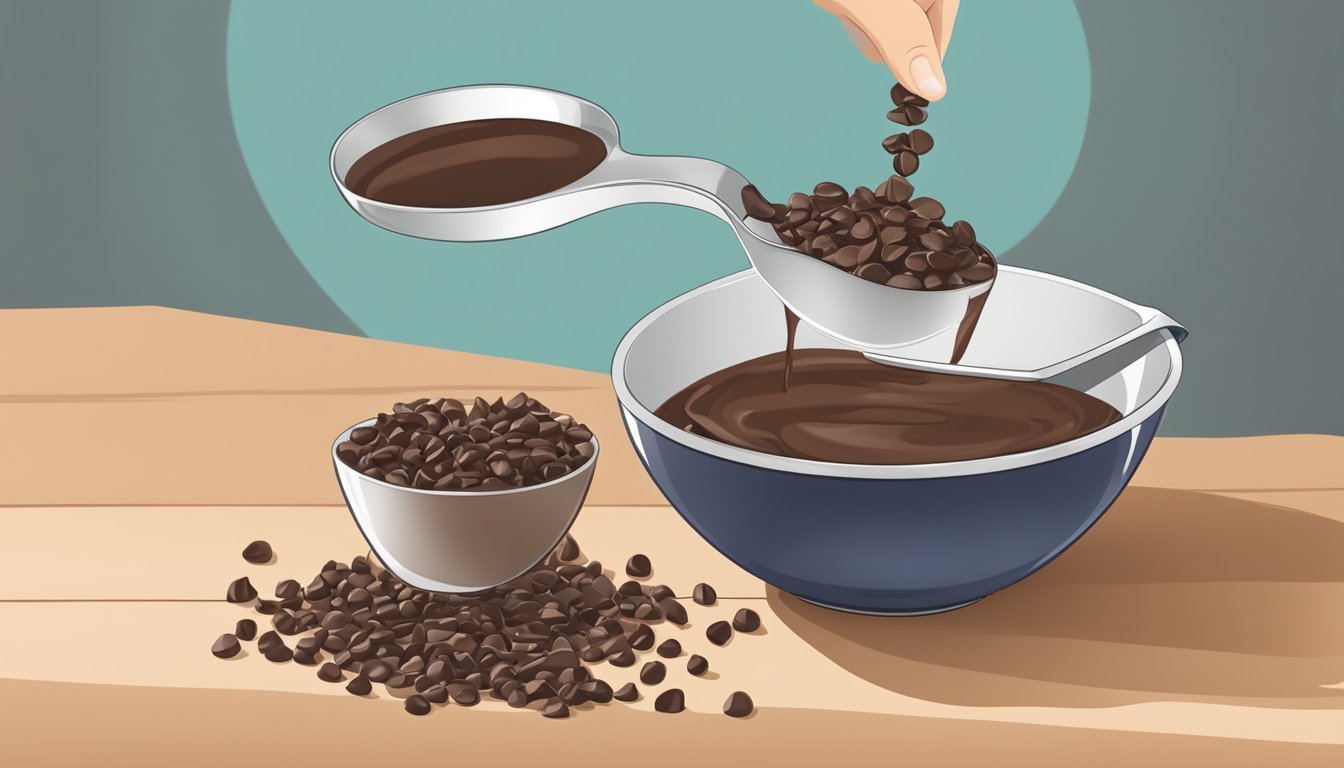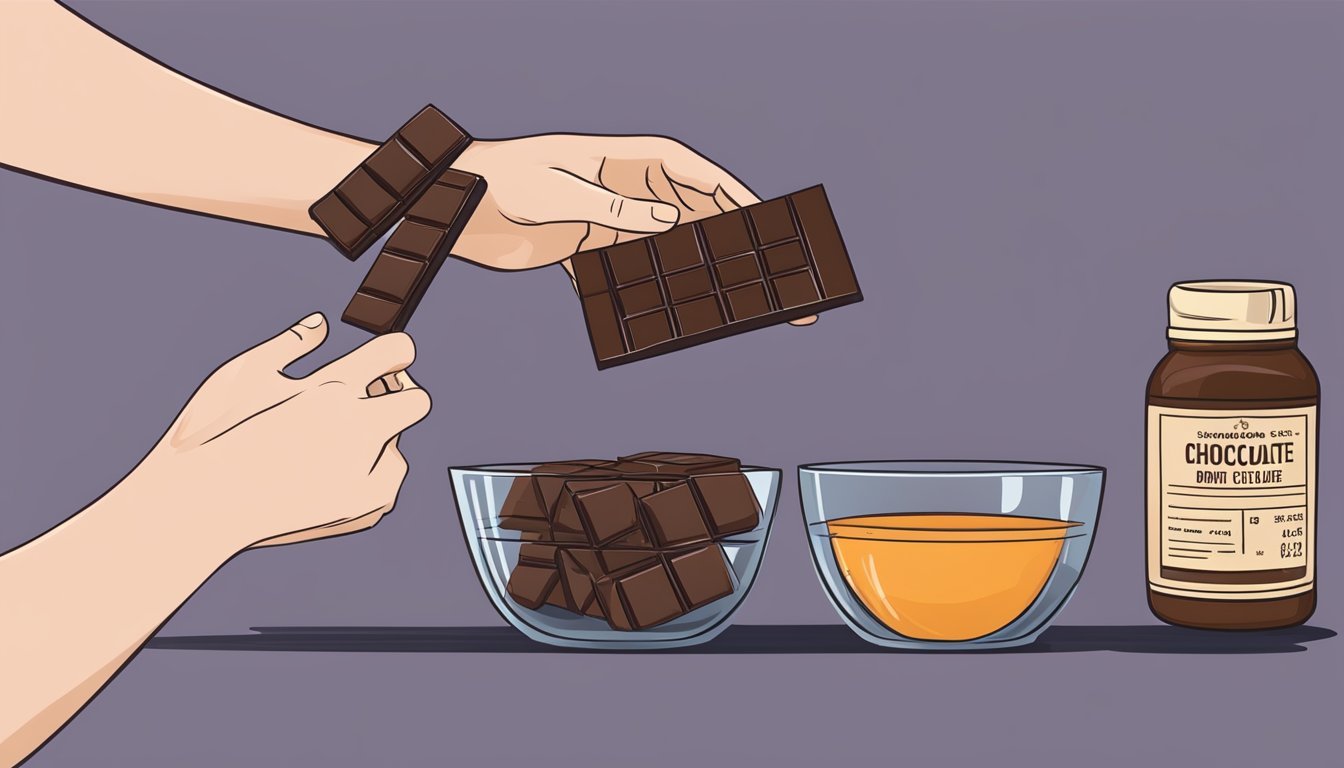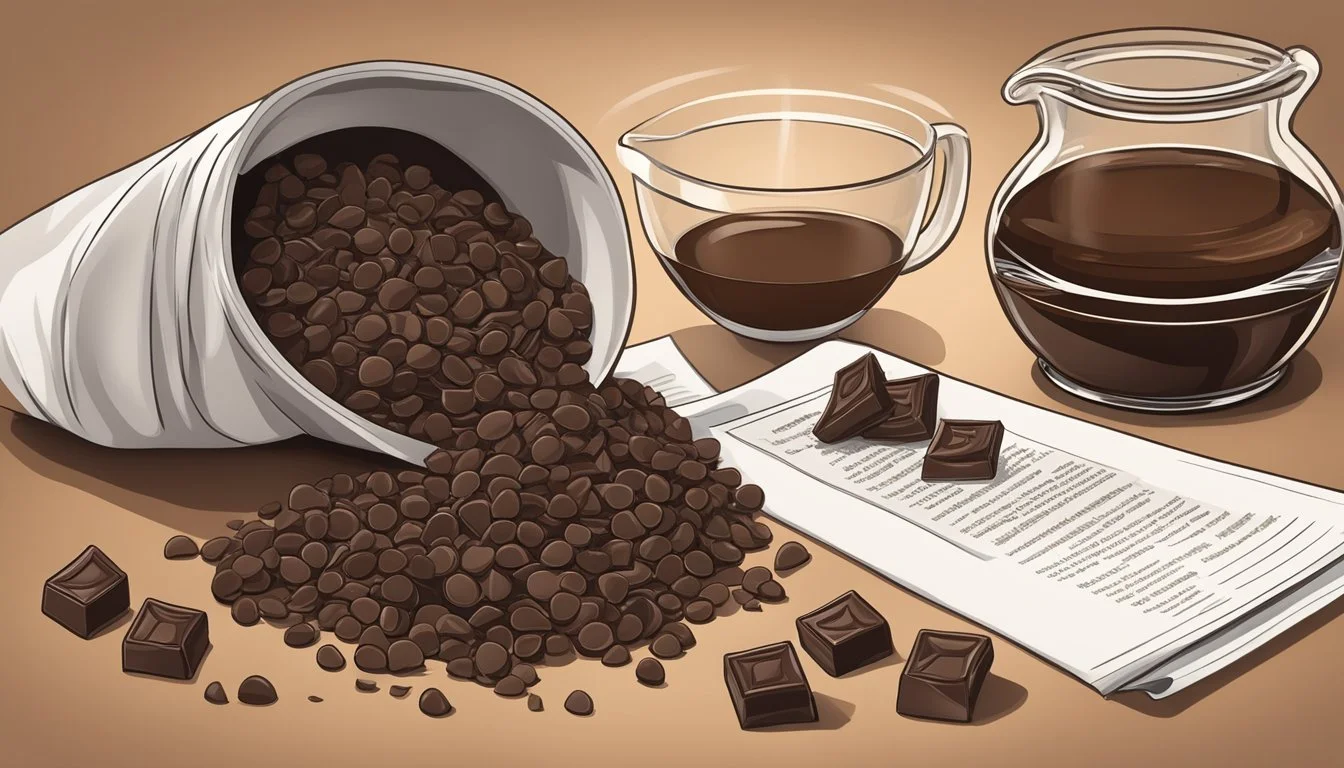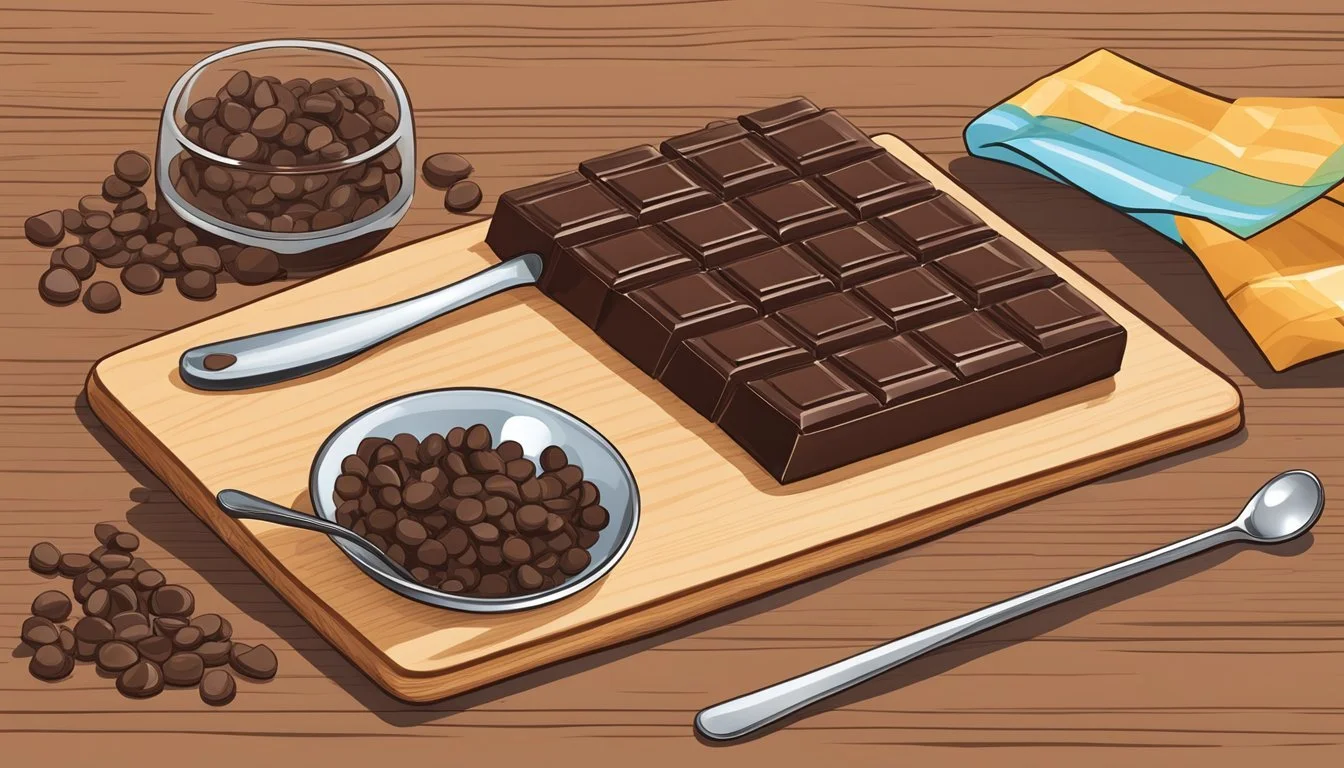How to Substitute Dark Chocolate for Semi-Sweet Chocolate
An Easy Guide
When it comes to baking and cooking, the type of chocolate (What wine goes well with chocolate?) used can significantly impact the flavor and outcome of the dish. Dark chocolate and semi-sweet chocolate are both popular choices in various recipes, but they have distinct tastes and properties that can affect the end product. Therefore, understanding how to substitute dark chocolate for semi-sweet chocolate correctly is important for any cook or baker striving to achieve their desired result.
Chocolate substitution requires careful consideration of the cocoa content and sweetness level as these factors influence the taste and texture of the final dish. Dark chocolate is known for its rich, intense flavor with a cocoa content that typically ranges from 70% to 99%. On the other hand, semi-sweet chocolate usually contains around 35-65% of cocoa mass and a balanced sweetness which makes it versatile for both baking and snacking.
For a successful substitution, one must compensate for the difference in sweetness between the two types of chocolate. In recipes, semi-sweet chocolate can often be replaced with dark chocolate, accounting for the variance in sugar content. A cook or baker may need to adjust the recipe by adding a bit more sugar to compensate for the lower sugar content in dark chocolate. Additionally, since dark chocolate has less sugar and more cocoa solids, it may offer a deeper chocolate flavor and slightly alter the texture of the dish, which could be preferable in some recipes.
Understanding Chocolate Types
This section focuses on differentiating various chocolate types based on cocoa content, texture, and flavor, which are crucial for selecting the appropriate chocolate for recipes or personal taste preferences.
Cocoa Content and Varieties
Cocoa Content: Chocolate is categorized by the percentage of cocoa solids it contains. The cocoa content influences the chocolate's flavor, texture, and sweetness. Cocoa solids are derived from cocoa beans, with higher percentages leading to less sweetness and a more intense flavor.
Unsweetened Chocolate: Nearly 100% cocoa solids, no sugar added.
Bittersweet Chocolate: Contains at least 35% cocoa solids, less sugar than semi-sweet.
Semi-Sweet Chocolate: Typically 35-65% cocoa solids.
Milk Chocolate: Usually has at least 10% chocolate liquor, at least 12% milk, with added sugar and cocoa butter.
White Chocolate: Contains cocoa butter but no cocoa solids.
Cocoa Bean Varieties: The type of cocoa bean also affects flavor.
Criollo: Less bitter, more aromatic.
Forastero: More common, stronger flavor.
Trinitario: Hybrid of Criollo and Forastero.
Properties of Dark Chocolate
Dark Chocolate is distinguished by a cocoa content ranging from 60% to 100%, delivering a robust chocolate flavor with varying degrees of bitterness. It often has a firmer texture and contains a higher proportion of cocoa solids and less sugar than other types. The fat content comes primarily from cocoa butter, which can affect the smoothness of the chocolate.
Properties of Semi-Sweet Chocolate
Semi-Sweet Chocolate is a versatile type with 35-65% cocoa solids balanced with sugar to create a harmonious flavor. It is widely used in baking due to its palatable sweetness and melting properties. Semi-sweet chocolate contains a moderate amount of cocoa butter ensuring a creamy texture that blends well in recipes.
Chocolate Flavor Profiles
Each type of chocolate has a unique flavor profile determined by the blend of cocoa content, sugar, and milk products, as well as the origin and treatment of the cocoa beans.
Bittersweet and Dark Chocolate: More intense and less sweet; often used in cooking and baking for deep chocolate flavor.
Semi-Sweet Chocolate: More balanced sweetness makes it suitable for a range of palates and applications.
Milk Chocolate: Creamier and sweeter due to higher dairy content.
White Chocolate: Sweet and rich in flavor from cocoa butter and dairy, but lacks cocoa solids' flavor.
In the context of substituting dark chocolate for semi-sweet chocolate, understanding these types is vital to ensure the desired outcome in both flavor and texture in culinary preparations.
Substitution Fundamentals
When replacing semi-sweet chocolate with dark chocolate in a recipe, one must consider flavor intensity, sweetness, and functional characteristics. The following subsections provide guidance to ensure successful substitutions.
Comparing Dark and Semi-Sweet Chocolate
Dark chocolate and semi-sweet chocolate are both derived from cocoa beans but vary in sugar content and cocoa mass percentage. Semi-sweet chocolate typically contains 35-65% cocoa mass and a balanced sugar level, whereas dark chocolate features less than 35% to upward of 70% cocoa mass with lower sugar content. To substitute, it is crucial to understand these variances to maintain the intended taste of the dish.
Adjusting Sweetness
The sweetness of semi-sweet chocolate often needs to be emulated when using dark chocolate as a substitute. Depending on the desired sweetness, one might need to adjust the sugar in the recipe. Here is a simple guideline for adjustment:
Cocoa Mass of Dark Chocolate Additional Sugar Needed per ounce of Chocolate 65-70% 1-2 teaspoons 70-85% 2-3 teaspoons 85% and above 3-4 teaspoons
Maintaining Texture and Consistency
Fat content in chocolate affects its melting properties and thereby the consistency of the final product. Dark chocolate, with a higher cocoa mass, may have less fat than semi-sweet chocolate. To balance the consistency, one may need to add a small amount of fat such as butter or vegetable oil. For every ounce of semi-sweet chocolate, substitute with one ounce of dark chocolate and consider adding approximately 1.5 teaspoons of fat to preserve the texture closest to that of the original recipe.
Practical Substitution Guide
When a recipe calls for semisweet chocolate and one only has dark chocolate on hand, understanding the proper conversions and ingredient ratios can ensure a successful result in baking or cooking.
Measurement Conversions
When substituting dark chocolate for semisweet chocolate, the most straightforward conversion is a one-to-one ratio by weight. For any given amount of semisweet chocolate, an equal weight of dark chocolate can be used. One should consider the sweetness level of the dark chocolate, as it typically contains less sugar than semisweet chocolate. To compensate, one might consider adding a small amount of sugar to the recipe.
1 ounce semisweet chocolate is roughly equivalent to 1 ounce dark chocolate.
To increase sweetness when using dark chocolate, add 1 teaspoon of sugar for every ounce of chocolate.
Alternative Ingredients and Ratios
In the absence of semisweet or dark chocolate, one can create a substitute using unsweetened cocoa powder, sugar, and a fat such as butter or oil. The following ratios provide a practical alternative to semisweet chocolate:
To replace 1 ounce of semisweet chocolate:
1 tablespoon unsweetened cocoa powder
2 teaspoons sugar
1.5 teaspoons of unsalted butter or vegetable oil
To mix, one should melt the butter or heat the oil to easily combine it with the cocoa powder and sugar until a uniform mixture is achieved. This blend can be utilized in recipes as a direct substitute for semisweet chocolate.
Amount of Semisweet Chocolate Unsweetened Cocoa Powder Sugar Butter or Oil 1 oz 1 tablespoon 2 tsp 1.5 tsp 2 oz 2 tablespoons 4 tsp 1 tbsp 3 oz 3 tablespoons 2 tbsp 1.5 tbsp
For those who prefer using chocolate chips instead, semisweet chocolate chips can serve as a direct substitute for semisweet baking chocolate, using an equal amount by weight. If using dark chocolate chips, consider the potential need for additional sugar as mentioned previously.
Application in Recipes
When substituting dark chocolate for semi-sweet chocolate in recipes, it is crucial to understand their differences in sweetness and cocoa content to achieve the desired flavor profile and texture.
Baking with Dark Chocolate
In baking, precision is key. Dark chocolate contains more cocoa solids and less sugar than semi-sweet chocolate, which can result in a deeper, less sweet chocolate flavor. For chocolate cake or brownies, one can substitute dark chocolate on a one-to-one basis, but might consider adding a slight amount of sugar to compensate for the bitterness. For instance:
Chocolate Cake: For every 1 ounce of semi-sweet chocolate, use 1 ounce of dark chocolate with an additional 1 teaspoon of sugar.
Brownies: Replace semi-sweet chocolate with dark chocolate directly, unless the recipe calls for extra sweetness.
Modifying Existing Recipes
Modifying recipes to include dark chocolate can enhance the chocolate flavor but may require slight adjustments. In cookies or other chocolate recipes, when replacing semi-sweet with dark chocolate:
Add a small quantity of sugar to balance sweetness, approximately ½ teaspoon per ounce of chocolate.
Reduce cocoa powder slightly if dark chocolate's cocoa content significantly surpasses that of the semi-sweet chocolate.
Here's an example:
Original Ingredient Substitute Additional Adjustments 1 oz semi-sweet chocolate 1 oz dark chocolate Add ½ teaspoon sugar (optional)
Chocolate in Savory Dishes
Dark chocolate can enrich savory dishes with its robust flavor. For dishes that incorporate semi-sweet chocolate, such as mole sauce, dark chocolate provides a profound taste profile that complements spices and savory elements. Be cautious not to let the bitterness overpower the dish:
Start with small amounts of dark chocolate and adjust to taste.
Pair with ingredients that can stand up to the intensity of dark chocolate, like chilies or bold spices.
Remember, whether in sweet baking chocolate confections or savory preparations, the key to substituting chocolate types is to balance flavors for an appealing outcome.
Common Challenges and Solutions
When substituting dark chocolate for semi-sweet chocolate, a baker may encounter issues with taste and consistency. The following subsections address these challenges and provide practical solutions to maintain the desired quality of your baked goods.
Addressing Bitterness and Sweetness Levels
Dark chocolate has a higher cocoa concentration and less sugar than semi-sweet chocolate, resulting in a more intense and less sweet flavor profile. To balance the bitterness and retain the expected sweetness when using dark chocolate as a substitute, one should add sugar. A rough guideline is to add one teaspoon of granulated sugar for every ounce of dark chocolate used to mimic semi-sweet chocolate's sweetness.
Bitterness Adjustment:
Dark Chocolate: Higher bitterness
Semi-Sweet Chocolate: Less bitter, more sugar
Solution: Add granulated sugar (1 tsp/ounce of dark chocolate)
Dealing with Viscosity and Melting Points
Dark chocolate and semi-sweet chocolate can differ in their melting points and viscosities, which affects texture and the blending of the chocolate into batters and doughs. Semi-sweet chocolate typically contains emulsifiers like soy lecithin, which helps stabilize the mixture and control texture. To achieve a similar effect with dark chocolate, consider incorporating a small amount of melted butter or vegetable oil. This not only helps to adjust the viscosity but also ensures a smoother melt.
Texture and Melting Point Adjustment:
Dark chocolate: May need to adjust for higher melting point
Semi-sweet chocolate: Added emulsifiers help with smooth melting
Solution: Add melted butter or oil (1.5 teaspoons/ounce of dark chocolate)
Health and Dietary Considerations
When substituting dark chocolate for semi-sweet chocolate, it’s important to understand their nutritional profiles and consider any dietary restrictions to ensure the choice aligns with health goals and requirements.
Nutritional Comparisons
Dark Chocolate:
Higher in cocoa solids (60-100%), leading to increased amounts of antioxidants.
Generally contains less sugar than semi-sweet chocolate.
May provide more fiber, iron, and magnesium per serving.
Semi-Sweet Chocolate:
Contains 35-65% cocoa solids.
Includes a moderate amount of sugar.
Relatively lower in fat compared to some dark chocolates.
Table of Nutritional Differences (per ounce):
Nutrient Dark Chocolate Semi-Sweet Chocolate Total Fat 12g 8g Saturated Fat 7g 4.5g Dietary Fiber 3g 2g Sugars 6g 8g Iron 3.3mg 1.1mg
Note: Values may vary based on brand and cocoa content.
Vegan and Allergy-Friendly Options
Vegan: Those on a vegan diet should ensure that the chocolate does not contain any animal products. Dark chocolate is often vegan, but it's critical to check the label for milk or milk derivatives.
Allergies: For individuals with allergies, it is essential to verify that the chocolate is free from allergens such as nuts, gluten, or soy, depending on the individual's sensitivities.
Fat Content: Both chocolates may contain milk fat or other fats, like butter oil, which are not vegan and can be problematic for dairy allergies. However, some brands offer vegan and allergy-friendly options that use alternate fats like vegetable oils.
To incorporate a substitute that fits dietary restrictions, both the nutritional content and ingredient list of the chocolate should be scrutinized closely to align with health and dietary needs.
Advanced Topics
In the process of substituting dark chocolate for semi-sweet chocolate, one must consider the intricacies of chocolate chemistry and flavor development. Advanced strategies focus on emulsifiers and flavor enhancers to refine the end product to fit specific culinary requirements.
The Role of Emulsifiers in Chocolate
Emulsifiers, such as soy lecithin, play a critical role in chocolate production. They are key to achieving a smooth consistency, allowing for the even distribution of cocoa and sugar particles. When substituting dark chocolate for semi-sweet, understanding the emulsifier content is crucial as it affects viscosity and texture. A higher concentration of emulsifiers can contribute to the richness of the chocolate's mouthfeel and maintain stability, especially if one incorporates additional elements like chocolate syrup or sauces.
Experimenting with Flavor Enhancers
To mimic the nuanced flavor profile of semi-sweet chocolate, experimenting with a variety of flavor enhancers is essential. Enhancers such as cinnamon or vanilla extract can be added to dark chocolate to bring out a richer, more robust taste that closely resembles that of semi-sweet chocolate.
Cocoa Mass: Increasing or decreasing the cocoa mass can alter bitterness and sweetness.
Flavor Enhancers:
Vanilla: Amplifies the inherent flavors in the chocolate.
Cinnamon: Adds a warm, spicy note that pairs well with the bitterness of cocoa.
By methodically varying these elements, one can tailor the dark chocolate to achieve the desired balance present in semi-sweet chocolate, ensuring the chocolate's role in recipes meets expectations.
Storage and Preservation
When substituting dark chocolate for semi-sweet chocolate, proper storage and preservation are crucial to maintaining the chocolate's quality and flavor. Both forms of chocolate should be stored in a cool, dry place such as a pantry or cupboard, away from any sources of heat or moisture.
Keep them in their original wrapping, or wrap tightly in foil or plastic wrap.
Place in an airtight container to protect from odors.
Ideal temperature is between 60°F and 68°F (15°C and 20°C).
Chocolate can be sensitive to temperature changes, so it is important not to store chocolate in the refrigerator or freezer as it can cause condensation or bloom, where sugar or fat rises to the surface.
Melted Chocolate:
Once melted, chocolate should be used immediately.
If there is leftover melted chocolate, let it solidify at a controlled room temperature before storage.
For preservation, remelt the solidified chocolate to ensure uniform consistency before use.
For Blocks or Bulk Chocolate:
Divide into smaller, manageable pieces for easier melting and storage.
Store in a covered container or resealable plastic bag.
Clearly label the containers with the type of chocolate and the date of storage.
By following these storage and preservation guidelines, one ensures that the distinct flavors and textures of dark and semi-sweet chocolate are well-preserved for baking and cooking needs.
Additional Tips and Tricks
When substituting dark chocolate for semi-sweet chocolate, one must consider the texture, sweetness, and flavor compatibility with other ingredients.
Working with Chocolate Substitutes
When working with chocolate substitutes, it is essential to understand that dark chocolate typically has a higher cocoa solid content and less sugar compared to semi-sweet chocolate. This can impact the sweetness of your final dish. An easy method to adjust sweetness if using dark chocolate is to add sugar incrementally. One should start with adding 1/2 teaspoon of sugar per ounce of dark chocolate and adjust to taste.
When melting chocolate, whether it be semi-sweet chocolate, white chocolate chips, or substituted types, it's critical to use gentle heat to prevent seizing. A double boiler or microwave at half power can be used effectively. To ensure a smooth melting process, the chocolate should be chopped consistently and stirred regularly.
Chocolate Pairings and Combinations
Chocolate flavor profiles can vary vastly, and pairing the right type of chocolate with complimentary flavors can elevate your dessert. Dark chocolate pairs well with bold flavors like nuts and banana. For instance, in a banana bread recipe, substituting semi-sweet chocolate with a rich dark chocolate can provide a more complex taste experience.
When creating confections like dipping sauces or preparing caramel coatings, one needs to balance the chocolate's bitterness by adding sweetness. For dark chocolate, pairing with sweet elements like honey or peanut butter can counterbalance the bitterness and create a rich, palatable flavor combination. Keep an eye on the consistency, as different sugar contents can slightly alter the viscosity of melted chocolate.
Recipe Inspirations
When substituting dark chocolate for semi-sweet chocolate in recipes, one should anticipate richer flavors and a slight increase in the bitterness of the end product. Dark chocolate typically contains higher amounts of cocoa solids and fewer sweeteners. This can enhance the depth in flavor profiles of various desserts and snacks, making for a more complex taste experience.
Dark Chocolate Dessert Recipes
Baking Recipes: Bakers can incorporate dark chocolate into classic treats, such as brownies and chocolate cakes, for a more intense chocolate kick. For instance:
Chocolate Lava Cakes: Swap semi-sweet chocolate with dark chocolate to elevate this indulgent dessert with a more sophisticated, less sugary taste.
Chocolate Tart: Use dark chocolate for the filling to lend a luxurious texture and bolder chocolate flavor that complements a buttery tart crust.
Pies and Tarts: A chocolate ganache pie made with dark chocolate instead of semi-sweet chocolate can transform this simple dessert into a rich and elegant dish. Here's how:
Dark Chocolate Truffle Pie: Create a ganache with dark chocolate and cream, pour it into a prepared crust, and chill until set.
Pudding and Truffles (What wine goes well with truffles?): The use of dark chocolate can add complexity to the creamy texture of puddings and the decadent nature of truffles.
Mexican Chocolate Pudding: Infuse dark chocolate pudding with cinnamon and a touch of chili for a fragrant and flavorful twist on a classic dessert.
Truffles: Roll truffles made with a dark chocolate ganache in cocoa powder or nuts for a variety of texture and taste contrasts.
Family-Friendly Snack Ideas
Bars and Puddings: Dark chocolate can elevate everyday snacks to something special, with its rich taste and healthful flavonoids.
Chocolate Granola Bars: Fold chunks of dark chocolate into granola mix for a nutritious yet indulgent snack.
Chocolate-Dipped Fruit: Melt dark chocolate to dip strawberries or banana slices, offering a family-friendly treat that balances sweetness with the antioxidant benefits of dark chocolate.
Mexican Chocolate Spiced Snacks: Introduce children to new flavors with snacks that utilize dark chocolate's affinity for spices.
Hot Chocolate with a Twist: Stir a piece of dark chocolate into warm milk and add a pinch of cinnamon for a comforting beverage on a cold day.











